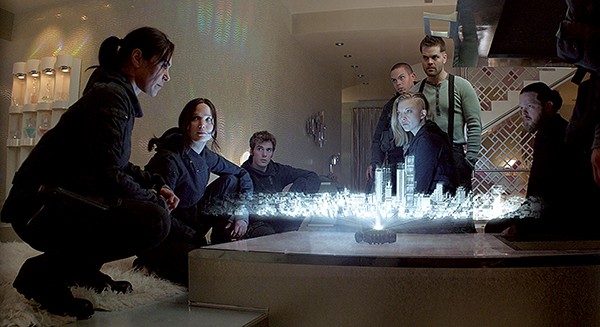The Hunger Games: Mockingjay-Part 2 is the latest in a growing series of films whose title contain both a colon and a hyphen, like The Twilight Saga: Breaking Dawn-Part 1. The paired punctuation has come to indicate a mangling by studio money-grubbing—one story has been split into two movies, and padding applied, to get you to shell out twice for closure.
Mockingjay completes The Hunger Games‘ unlikely transition from winking high school allegory to grimdark military science fiction. Our beloved heroine, Katniss Everdeen (Jennifer Lawrence) begins part two in a familiar setting: a hospital bed, recovering from wounds she received in battle. In this case, she was put in the hospital by her former fiancé and fellow survivor of the arena, Peeta (Josh Hutcherson), who was brainwashed into hating her by the forces of the Capitol, led by President Snow (Donald Sutherland). Sporting the thousand-yard PTSD stare she adopted in Part 1, Katniss meets with the leader of the rebels, President Alma Coin (Julianne Moore), and agrees to drop her former ethical reservations and do whatever it takes to defeat the Capitol. She is immediately thrust into battle in District 2 beside her second love interest, Gale (Liam Hemsworth), in an effort to destroy the last enemy stronghold blocking the way to an advance on the Capitol. When the post-battle evacuation of civilians threatens to turn into a riot, Katniss manages to partially defuse the situation before being shot by a loyalist refugee. After once again waking up in a hospital bed, she vows to personally kill Snow. Katniss defies the authority of Coin and her propaganda minister Plutarch Heavansbee (the late Philip Seymour Hoffman, whose absence the filmmakers work around with fragments of dialogue and CGI) to get into the battle at the Capitol, where the rebels must fight their way through a booby-trapped city to topple Snow’s teetering regime.

The Hunger Games: Mockingjay-Part 2
There’s a core of classic sci-fi running through all of Suzanne Collins’ Hunger Games novels, which became best sellers in the vacuum left by the completion of the Harry Potter cycle. One of the interesting things about Harry Potter is its author, J.K. Rowling, offered a decidedly female take on the formerly male-dominated realm of epic fantasy, and the same dynamic is at work with Collins in the world of dystopian science fiction. Katniss is an action hero, but she’s also a reality TV star who has her own stylist. The story focuses very tightly on her character, and her two would-be boyfriends get about as much development as your typical Bond girl. The dystopia Collins paints is an artfully rendered funhouse mirror-version of contemporary America—surely, the Capitol is the most garish evil empire in film history.
Unfortunately, the film adaptations have not served Collins’ vision as well as the Harry Potter films did Rowling’s. The first film was barely competent, and the second was only an incremental improvement. The only great thing about the franchise has been Lawrence’s muscular, multifaceted portrayal of Katniss. And if Mockingjay had been just one movie, Lawrence might have finally gotten a film worthy of her talents. Katniss has grown from scared country girl to a hardened warrior who can take a nap as the dropship flies her to the war zone. At least director Francis Lawrence has the good sense to bring the series to a close by hiring a decent editor and giving Lawrence lots of close-ups.
But like The Hobbit films, there’s just no saving the movie from the financial imperative to split the story. There’s a solid two-hour movie buried somewhere in the 260-minute combined running time of the two Mockingjays, but, as it is, the beats just fall in all the wrong places. Part 2 builds some decent tension, particularly in a claustrophobic sequence where our heroes fight mutant attack zombies in the Capitol’s sewers, but the overall structure has been so fatally compromised that Katniss just seems to drift around in a haze of nonsensical plot complications. When our long-suffering hero gets her much-deserved rest, we share her relief that it’s finally over.